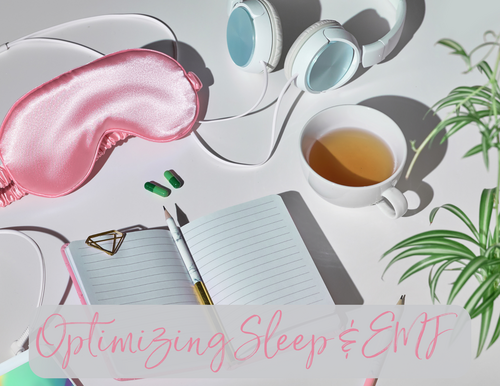Optimizing Sleep & EMF

Sleep is a cornerstone of health, playing a crucial role in brain function (including learning focus and concentration), mood regulation (enabling better management of stress and emotions), growth and healing, boosting the immune system, heart health, weight management, blood sugar regulation and more. However, achieving quality sleep can be challenging due to various factors such as room temperature, exposure to light, and even exposure to electromagnetic fields (EMFs) from electronic devices, which may disrupt our natural sleep cycles.
Did you know?
Natural Ways to Optimize Sleep:
Did you know?
- A single day of sleep deprivation can increase cortisol levels by over 100%
- Less than 5 hrs of sleep increases your risk of dementia 2-fold
- Shortened sleep duration has been found to increase Type 2 diabetes -- after 6 days of sleep restriction, there was a 50% decrease in insulin sensitivity.
Natural Ways to Optimize Sleep:
- Improve your Bedroom Environment
- Make your bedroom as dark as possible and temps between 56-63F
- Remove the TV (and other electronics) from the bedroom -- use the bedroom for sleep or sexual activities only
- Nutrition for Better Sleep
- Eat more protein during the day & low carb dinner, ensuring last bite is 2-3 hrs before bedtime
- Avoid alcohol, stimulants (nicotine, caffeine) after mid-day
- Movement for Better Sleep
- Avoid high intensity exercise at least 3 hrs prior to bedtime
- Best morning exercises -- cardio (biking, running, cycling); best evening exercises - yoga, tai chi, etc.
- Detoxing your Home for Better Sleep
- Use blue wavelength-blocking glasses 1-2 hrs prior to sleep
- Avoid electronic devices at least 1 hr prior to bedtime, turning off the WIFI at this same time.
- Creating a Routine for Better Sleep
- Aim to fall aslseep by 10pm. Most of your deep sleep happens before midnight
- Aim for 15 min of bright light exposure as soon as you wake
Electromagnetic fields (EMF) or "electronic pollution" are invisible areas of radiation that could be impacting your sleep and overall health. Studies have found EMFs can lead to difficulties falling asleep, lighter sleep stages, waking up more frequently throughout the night, and even contribute to sleep apnea.
Did you Know?
EMF Hygiene Checklist2
Did you Know?
- "After the implementation of circuit cut-off switches and/or shielding, two-thirds of all patients with sleep apnea were able to do without their CPAP devices; pauses in breathing had completely disappeared!"1
- Chronic exposure to low-frequency EMFs is linked to increased stress, depression, anxiety as well as poor sleep quality.
EMF Hygiene Checklist2
- Home Health
- Replace flourescent bulbs with incandescent, halogen or non-dimmable LED (in order of preference).
- Opt out of your smart meter with your power company
- Building new or planning a move? Consider a metal roof, shielded wiring and wall shielding
- Home Office
- Remove/unplug unnecessary cables from computer work area and use wired ethernet, wired mouse, and wired keyboard
- Use hardwired internet only and leave off WIFI.
- Use your phone in "FULL" Airplane Mode
- Turn ON "Airplane Mode"; Turn OFF (in settings) WIFI, Bluetooth, Hotspot, Airdrop, Location, Find my iPhone, Find My Network
- Schedule a "home assessment" to learn your current exposure levels and how to fix them. Geovital is a company out of Australia that offers this service with consultants located in the USA.
A functional medicine approach to sleep optimization involves identifying and addressing underlying causes such as hormonal imbalances, stress, and nutrient deficiencies. By incorporating sleep hygiene practices like the ones mentioned in this article you can improve your sleep quality and overall well-being.
Sources:
1. Greschek, Michael. “Electronic Pollution Promotes Sleep Apnea - En.geovital.com [EN].” En.geovital.com [EN], 8 May 2014, en.geovital.com/electronic-pollution-emf-promotes-sleep-apnea/. Accessed 7 Mar. 2025.
2. EMF Hygiene Checklist, Angela Doherty Geovital Consultant, www.reclaimedhealing.com
3. “Chronotypes: Definition, Types, & How They Affect Sleep.” Sleep Doctor, 16 Nov. 2022, sleepdoctor.com/how-sleep-works/chronotypes.
4. Huberman Labs. “Sleep Toolkit: Tools for Optimizing Sleep & Sleep-Wake Timing.” Youtu.be, 2025, youtu.be/h2aWYjSA1Jc?si=vbv9C1SfFZ9xVAur. Accessed 7 Mar. 2025.
5. Patrick, Rhonda . “Aliquot #104: The Science of Optimizing Sleep.” FoundMyFitness, 2024, www.foundmyfitness.com/episodes/aliquot-104-science-optimizing-sleep. Accessed 7 Mar. 2025.
6. “Setting-up Success for Sleep Support - Functional Nutrition Alliance.” Fxnutrition.com, 2019, www.fxnutrition.com/blog/post/setting-up-success-for-sleep-support. Accessed 7 Mar. 2025.
1. Greschek, Michael. “Electronic Pollution Promotes Sleep Apnea - En.geovital.com [EN].” En.geovital.com [EN], 8 May 2014, en.geovital.com/electronic-pollution-emf-promotes-sleep-apnea/. Accessed 7 Mar. 2025.
2. EMF Hygiene Checklist, Angela Doherty Geovital Consultant, www.reclaimedhealing.com
3. “Chronotypes: Definition, Types, & How They Affect Sleep.” Sleep Doctor, 16 Nov. 2022, sleepdoctor.com/how-sleep-works/chronotypes.
4. Huberman Labs. “Sleep Toolkit: Tools for Optimizing Sleep & Sleep-Wake Timing.” Youtu.be, 2025, youtu.be/h2aWYjSA1Jc?si=vbv9C1SfFZ9xVAur. Accessed 7 Mar. 2025.
5. Patrick, Rhonda . “Aliquot #104: The Science of Optimizing Sleep.” FoundMyFitness, 2024, www.foundmyfitness.com/episodes/aliquot-104-science-optimizing-sleep. Accessed 7 Mar. 2025.
6. “Setting-up Success for Sleep Support - Functional Nutrition Alliance.” Fxnutrition.com, 2019, www.fxnutrition.com/blog/post/setting-up-success-for-sleep-support. Accessed 7 Mar. 2025.

No Comments